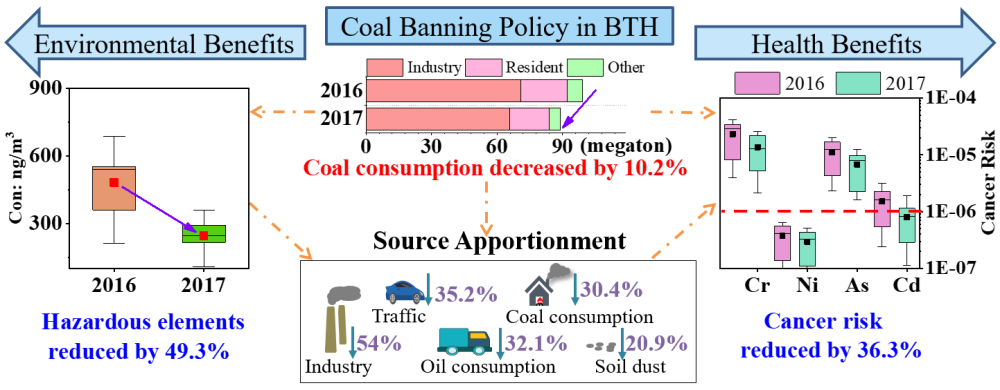Establishing a Coal Banning Area in the Beijing-Tianjin-Hebei Region of China Brings Environmental and Health benefits
Date:2021-04-30
Due to the high emission and poor diffusion of the Beijing-Tianjin-Hebei region of China (BTH), atmospheric environmental quality and pollution control have always attracted attention in the region. As early as 2013, the State Council issued the Action Plan for Air Pollution Prevention and Control, requiring that the average concentration of PM2.5 in the BTH region should decrease by 25% in 2017. In order to achieve this goal, the Ministry of Ecology and Environment set up a coal banning area, 10,000 km2, in the region in October 2017. In this area, the scattered pollution industries were cleaned up, and livelihood coal was replaced with clean energy in the villages and towns. Compare to 2016, the consumption of coal reduced by 10.2%, about 10.14 million tons in BTH in 2017. Industrial coal fell by 5.29 million tons and household bulk coal by 4.85 million tons.
A team led by Prof. XIN Jinyuan with the Institute of Atmospheric Physics at the Chinese Academy of Sciences conducted large-scale observation experiments of PM2.5 components in the Eastern China from 2016 to 2019.
"We found compared to 2016, the reduction rate of PM2.5 was as high as 63.5% in 2017, and the total elements of PM2.5 fell by 43.0%." said Prof. XIN.
The health risk of BTH was evaluated by the U.S. EPA's health risk assessment model, which divided the health risk into carcinogenic risks (elements as Cr, Ni, As, and Cd) and non-carcinogenic risks (elements as Cr, Mn, Ni, Cu, Zn, As, Cd, and Pb). The carcinogenic risk and the non-carcinogenic risk of BTH reduced by 36.3% and 49.3%, respectively, in 2017, which were much higher than the reduction rate of coal consumption.

After the establishing of the coal banning area, the environmental and health benefits improved significantly in BTH. (Image by XIn Jinyuan)
Source apportionment of elements illustrated that the coal consumption of BeiJing (BJ) attained the largest reduction by 60.3%. As the significantly decreases of the total elements,although the proportion of coal combustion had risen in TianJin (TJ), ShiJiaZhuang (SJZ), BaoDing (BD), XiangHe (XH), and XingLong (XL), the actual emissions from coal combustion had decreased by 13.6-36.8% in 2017 (Figure 1). The health risk assessment of research sites revealed that Cr and As had carcinogenic risks in BTH, and Ni posed no carcinogenic risk. The carcinogenic risks of coal consumption had been reduced by 30.7-48.3% after setting the coal banning area in the region (Figure 2). The research reveals the nonlinear relationships between air pollution control, the reduction of PM2.5, environmental and health benefits.
"Our results show positive effect of strict control of coal emissions in BTH. In urban or urban agglomeration regions, the scientific control of the pollution emission in the key area will bring significant environmental benefits to the whole region." Said Prof. XIN.
